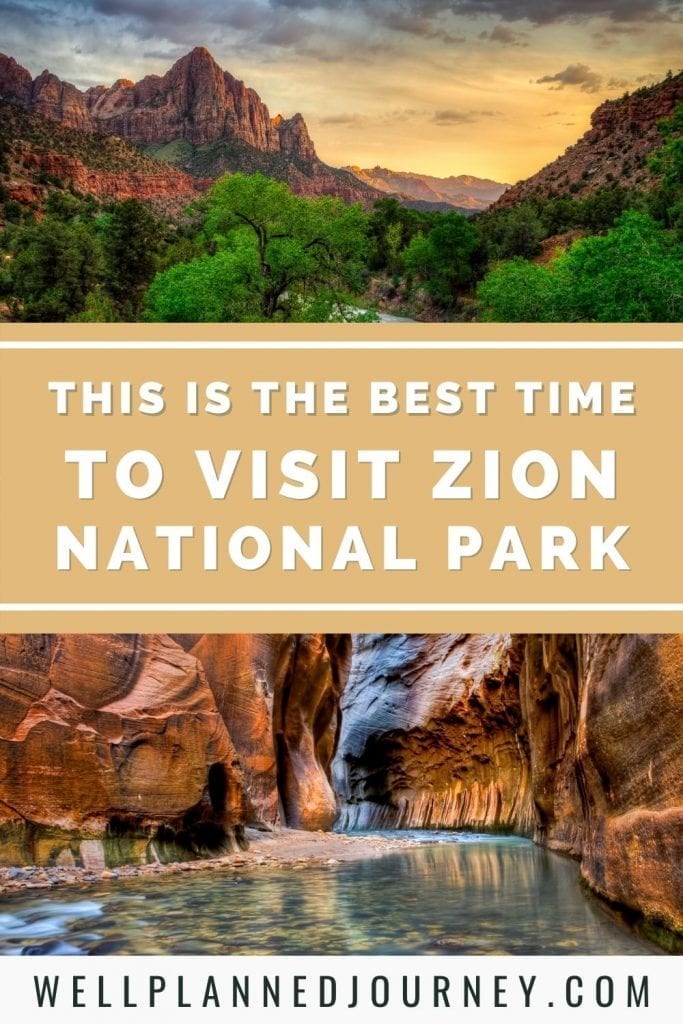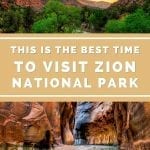Every Summer, millions of people flock to Zion National Park to hike some of the best trails in the country. But this isn’t actually the best time to visit Zion National Park!
From the blooming wildflowers of Spring to the yellow Aspens of Fall, you’ll find beauty all year long. The best time to visit Zion National Park depends on the weather, crowds, and your interests!
This guide takes you through the best season to visit Zion for hiking, camping, the best weather, avoiding crowds, and more! Keep reading to get a feel for the best time for you to visit Zion National Park.
This post may contain affiliate links, where I may receive a small commission at no additional cost to you. Read more in this disclosure policy.
Zion National Park At-A-Glance
Before diving in, here are a few highlights to help you plan your trip:
- Best Time to Visit: Spring or Fall are the best times to visit thanks to mild weather, perfect for hiking. Avoid crowds by visiting in March or November, on either end of peak season.
- Where to Stay: If you’re looking to stay in the park, your best option is Zion Lodge. If you’re looking to stay outside the park, I highly recommend either Cliffrose Lodge or Driftwood Lodge in Springdale.
- How to Get There: The closest airports are in Las Vegas (3 hours away) or Salt Lake City (4.5 hours away). Use Expedia to browse flights and find the best price.
- How to Get Around: Zion National Park requires visitors to take the free shuttle from Spring to Fall. However, you’ll still need your own car to get to Zion. Use Expedia to browse deals on rental cars or rent an RV or campervan with Outdoorsy!
- Best Self-Guided Tour: My favorite way to learn more about the park is with GyPSy Guides, a narrated self-guided tour perfect for road trips and scenic drives. The Zion & Bryce Canyon Guide and the Utah “Mighty 5” Bundle both provide incredible commentary and detail about the history and geology of these parks.
- Don’t Forget: Be sure to get an America the Beautiful National Park Pass ahead of time. This $80 pass is valid for 12 months and get you into all 400+ national park sites (including Zion!).
Zion National Park Weather by Month
Weather in Zion varies dramatically by season, from scorching hot summers to snowy winters. Your first consideration when planning a trip to Zion should be the weather.
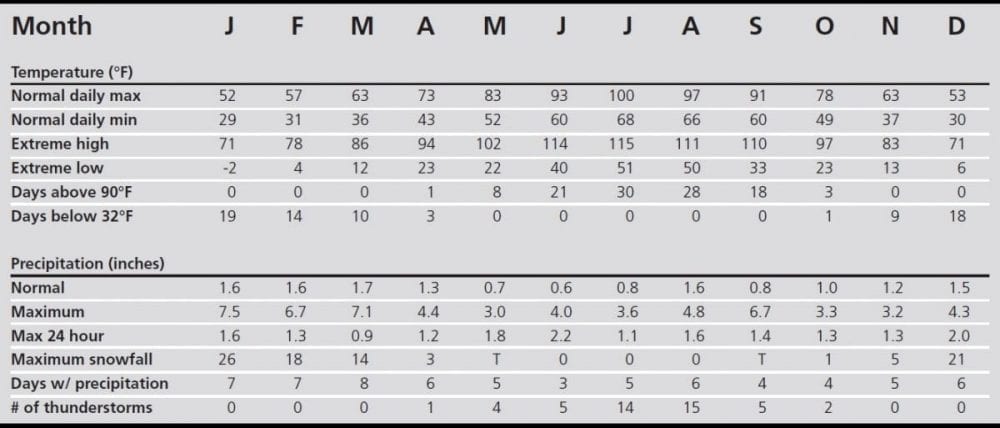
In the summer, daytime temperatures stay over 90 degrees and are known to get up to 115 degrees on the hottest days.
Summer is also monsoon season in Zion, with about 15 thunderstorms a month. These storms can be incredibly dangerous, causing flash floods in the canyon.
In the winter, temperatures hover around 50 degrees during the day but drop below freezing overnight. Snow falls frequently at higher elevations.
Ice and snow rarely accumulate on the floor of Zion Canyon, the main pathway through the park, making Zion an easy park to navigate in the Winter.
In spring and fall, temperatures are cool in the morning and comfortable by midday. These seasons are the best time to hike in Zion National Park, avoiding the scorching heat of summer and the cold of winter.
Zion National Park Visitors by Month
Zion National Park is the 4th most visited national park in the United States. It’s only outranked by the Great Smoky Mountains, Grand Canyon, and Rocky Mountain.
With nearly 4.5 million visitors per year, crowds are commonplace. So much so that you should consider planning your trip to avoid crowds!
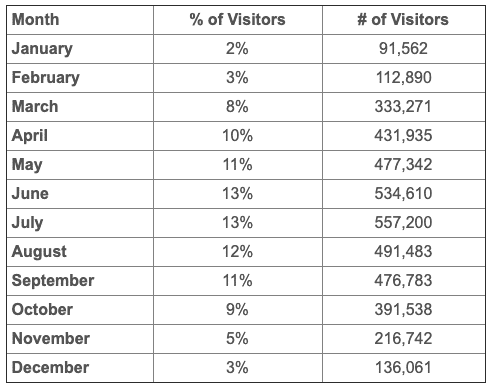
Summer is the busiest season in Zion, with nearly half of the annual visitors coming between Memorial Day in May and Labor Day in September.
On an average Summer day, over 17,000 people will enter Zion National Park.
Compare that staggering statistic to the visitation in the winter, when less than 3,000 people venture into Zion Canyon per day. The park gets less than 10% of its annual visitors from December to February.
The rest of the year, called the “shoulder months”, average between 7,000 and 15,000 visitors per day. For those looking for great weather and fewer crowds,
Spring and Fall are the best time to explore Zion National Park.
Visiting Zion National Park in the Spring
Best time to visit if you’re interested in: Avoiding crowds, hiking, and spotting wildflowers

In Spring, Zion Canyon is filled with blooming wildflowers and plenty of water. As the temperatures rise, the snow that accumulated over the winter starts to melt. The runoff ends up in the Virgin River that flows throughout the park.
Water levels rise, creating waterfalls only seen in these few short months. Animals begin exploring the park again and wildflowers cover the most popular hiking trails.
But the growing temperatures come with growing crowds, particularly around Spring Break.
Most park services are open during the Spring, including the Zion Canyon Shuttle and campgrounds.
Pros of Visiting Zion in the Spring
- Wildflowers cover the park
- The only time of year to see waterfalls, like on the Emerald Pools trail
- Fewer crowds than in peak Summer months
- Great time to spot wildlife
- Day time temperatures are perfect for hiking
- Park services are fully operational – campgrounds and visitor centers are open
Cons of Visiting Zion in the Spring
- Spring Break brings heavy crowds in March
- Some higher-elevation trails may still be closed in early Spring
- Water levels are too high to hike The Narrows
- Visitors are required to take the Zion Canyon Shuttle
- Nights can be cold for camping
Best Things to Do in Zion National Park in the Spring
Comfortable day time temperatures and fewer crowds make Spring a great time to hike in Zion. You can spot waterfalls on the Emerald Pools trail or beat the summer crowds on the popular Angels Landing trail.
These are the best trails to hike in Zion in the Spring:
- Emerald Pools
- Angels Landing
- Observation Point
- Hidden Canyon
Due to high water levels in the spring, The Narrows (one of Zion’s most popular hikes) is closed and usually opens in late May.
Important Note
Zion National Park is requiring all visitors to get an advance permit to hike Angels Landing. You can read more about how to get an Angels Landing permit here.
The main route to Observation Point is closed due to a rockslide in 2019. However, there’s an alternate route to reach the peak, which you can read about in my Observation Point blog post.
Visiting Zion National Park in the Summer
Best time to visit if you’re interested in: Traveling while the kids are out of school, ranger-led activities, and warm weather
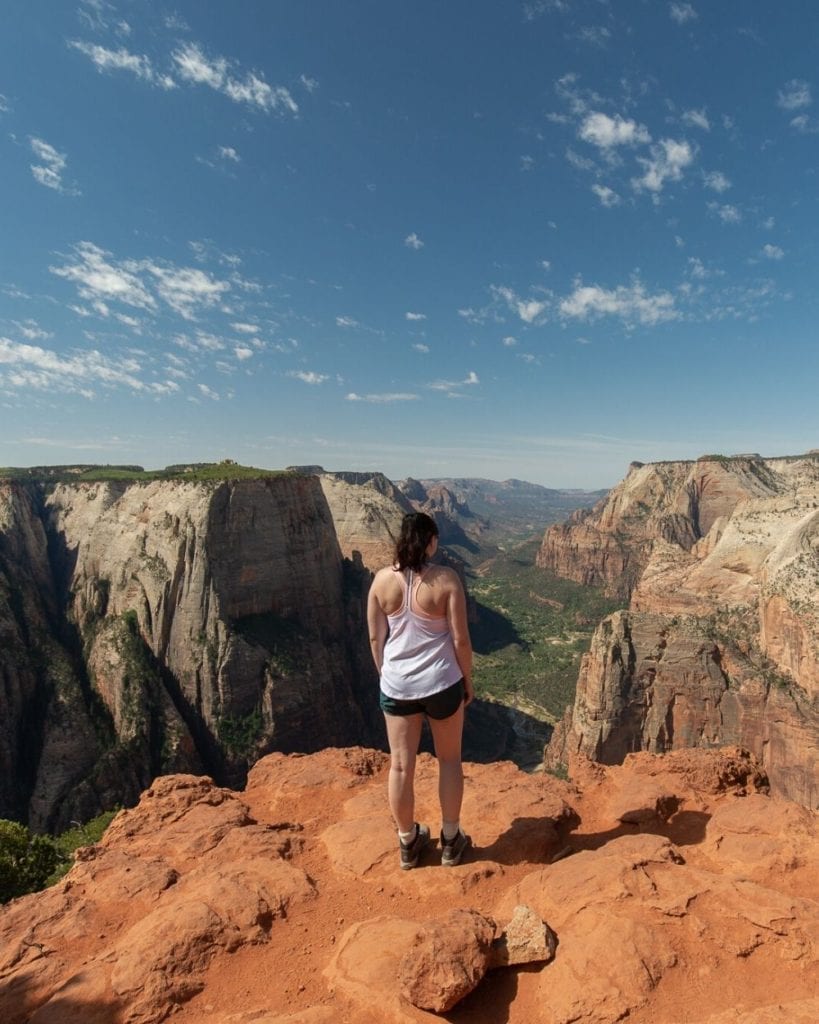
The days are longer, the snow is melted, and Zion’s peak season is in full swing. From Memorial Day to Labor Day, Zion National Park gets 40% of its annual visitors.
On any given day, you can expect over 17,000 people in the park.
Summer crowds mean crowded trails and crowded shuttles. But you can avoid some of the crowds by starting your day early and hitting the trail at sunrise.
But don’t get me wrong – Summer in Zion is still amazing and comes with one serious pro: The Narrows.
By June, the Virgin River has calmed, making The Narrows the most popular summer attraction. This trail takes you wading through the river bed, providing a cool refresh from the heat.
Pros of Visiting Zion in the Summer
- Temperatures are warm, even overnight
- Kids are out of school
- All park services and visitor centers are open
- The Zion Canyon Shuttle makes all areas of the park easily accessible
- The Narrows is open and the water is warmer
Cons of Visiting Zion in the Summer
- Thunderstorms are frequent during monsoon season (July to September) and cause flash floods near the Virgin River
- Crowds are heavy – expect lines for the shuttle and hiking Angels Landing
- Hotels in Springdale are the most expensive
- Campgrounds fill as soon as reservations open, 6 months in advance
- Midday temperatures can be over 100 degrees in July and August
- Visitors are required to take the Zion Canyon Shuttle
Best Things to Do in Zion National Park in the Summer
Summer in Zion is popular for a reason – it’s the time of year when all trails are open and the park is most easily accessible.
The days are also the longest in the summer. Take advantage of this by exploring the park from sunup to sundown!
The best summer adventures in Zion are:
- The Narrows
- Angels Landing
- Hiking Observation Point
Summer is also a popular time to visit other nearby national parks like Bryce Canyon National Park.
Read More: Ultimate Guide to Bryce Canyon
Visiting Zion National Park in the Fall
Best time to visit if you’re interested in: Hiking The Narrows, spotting fall colors, and avoiding crowds

After a busy summer, crowds die down as the leaves on the cottonwoods and aspens turn orange and yellow. I think Zion is one of the prettiest national parks in the fall!
For peak colors, visit Zion in late October or early November.
Temperatures cool down, better for hiking, and the Virgin River remains warm for exploring The Narrows.
While fall tends to be less crowded, holiday weekends like Labor Day, Columbus Day, and Thanksgiving rival summer crowds.
Pros of Visiting Zion in the Fall
- Fall colors are impressive against the canyon walls
- Temperatures are perfect for hiking
- The Narrows is still open
- Crowds are fewer than in Summer
- Zion Canyon Shuttle is still running making the park more accessible
Cons of Visiting Zion in the Fall
- September is the end of monsoon season which brings frequent thunderstorms and flash floods
- Holiday weekends bring summer-level crowds
- Early snowstorms can close some hiking trails
- Nighttime temperatures can be too cold for unprepared campers
- Visitors are required to take the Zion Canyon Shuttle
Best Things to Do in Zion National Park in the Fall
While Spring and Summer provide good hiking conditions, Fall is by far the best time of year for hiking in Zion National Park. The park shuttle is still running, but less frequently, so start your day early to hit the best trails in Zion!
Don’t miss these awesome hikes in the Fall when crowds are fewer:
- The Narrows
- Angels Landing
- Observation Point
- Hidden Canyon
Fall is also a great time to check out Utah’s other national parks!
Read More: Utah “Mighty 5” Road Trip Itinerary
Visiting Zion National Park in the Winter
Best time to visit if you’re interested in: Winter sports like snowshoeing, hiking in solitude, and spotting wildlife
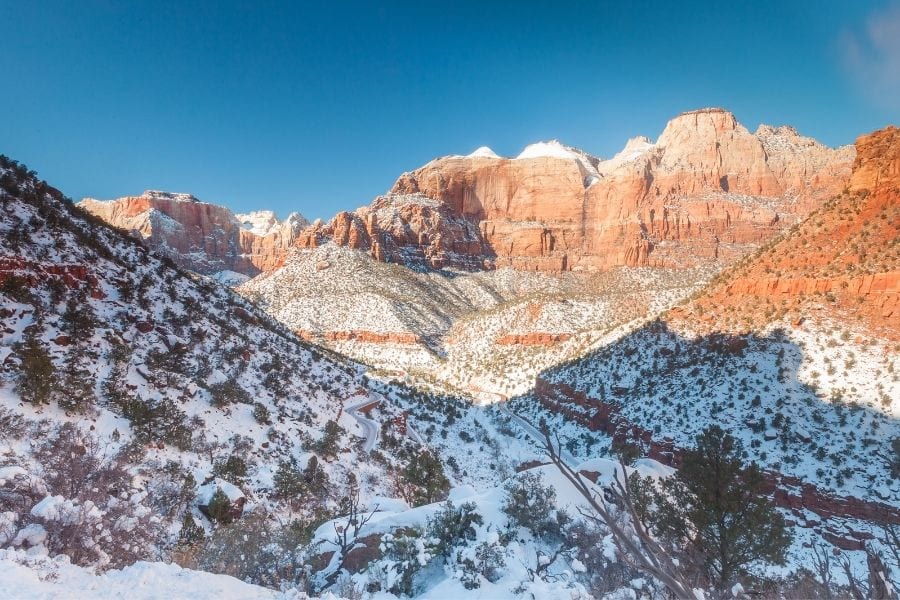
By December, snow has started to fall in Zion National Park, blanketing the higher elevation parts of the canyon.
But Zion doesn’t get as much snow as the surrounding national parks – the perfect amount for winter exploration!
In the Winter, Zion gets half of its annual participation. The snow and ice can close some of the park’s popular trails like Angels Landing and require shoe spikes on other trails.
But those that choose to brave winter in Zion will be rewarded with solitude like no other time of year. A typical winter day in Zion only brings in 3,000 people, compared to 17,000 in the summer.
Pros of Visiting Zion in the Winter
- Crowds are nonexistent
- Zion Canyon Road is open to vehicles (except on holiday weekends when the shuttle runs)
- Wildlife sightings are common as the animals move to lower elevation to avoid the cold
- Hotels in Springdale are cheapest in winter – it’s a great time to find hotel deals!
- The only time of year you can snowshoe and cross-country ski in Zion
Cons of Visiting Zion in the Winter
- Some trails are closed due to snow and ice. Angels Landing has frequent closures due to weather and The Narrows is too cold.
- Temperatures are cold overnight, often well below freezing
- Hiking can require extra gear like snow spikes for your hiking boots
- The shuttle only runs on holiday weekends, making the park less accessible
- Higher elevation areas like Kolob Canyon are closed when it snows
- Park services like the visitor center have limited hours
- Only Watchman Campground is open and is first-come, first-served
Best Things to Do in Zion National Park in the Winter
Snow in Zion makes for beautiful photos and even better adventures! Winter is the perfect time to explore Zion’s hiking trails without the crowds.
The best things to do in the Winter are:
- Snowshoeing and cross-country skiing
- Driving Zion Canyon Road (only time of year you can do this)
- Hiking trails on Zion’s canyon floor
If you choose to brave the cold in Zion, you’ll likely be the only one on the trail, so bring extra layers, plenty of water, and the 10 hiking essentials.
Don’t miss the best of Utah’s national parks on your upcoming trip! This free, printable Utah national park road trip itinerary covers all the best points of interest in all 5 Utah parks, plus bonus tips on where to stay and side trips to nearby state parks and monuments.
Download your free Utah road trip itinerary here.
The Best Time of Year to Visit Zion National Park

The best time to visit Zion National Park will depend on your personal preference. Think about what you want to do while you’re there.
Is The Narrows on your bucket list? Do you want to avoid crowds at all costs?
Once you know your top priorities, pick the best time to visit for you!
All Around Best Time to Go to Zion National Park
For the average national park explorer, late spring or early fall is the best time to visit Zion. From April to May and September to October, the weather is good, crowds are fewer, and hiking conditions are optimal.
Best Time to Go to Zion National Park to Avoid Crowds
For those that hate crowds, avoid summer in Zion at all costs. The least crowded months in Zion are December to February when the weather is cold. If you’re looking for warmer weather with fewer crowds, consider visiting from March to April or October to November instead.
Best Time of Year for Driving Zion Canyon Scenic Drive
Zion Canyon Road is only open to cars in the winter when the park shuttle isn’t running. If you want to drive through the park yourself you’ll want to visit in January or February.
Best Time of Year to Hike Angels Landing
The Angels Landing trail is open all year long, with occasional winter closures after a storm. Angels Landing is already a dangerous trail – icy conditions or extreme heat can make the hike even more dangerous. For the best conditions, hike Angels Landing from March to June or September to October.
Important Note
Zion National Park is requiring all visitors to get an advance permit to hike Angels Landing. You can read more about how to get an Angels Landing permit here.
Best Time to Hike The Narrows
The Narrows is a popular hike through the knee-deep Virgin River. Due to cold water temperature and high water levels, the trail is closed in winter and spring. The best time to hike The Narrows is from late May to October, but watch out for summer thunderstorms that can cause deathly flash floods.
When to Visit Zion National Park for Camping
Zion has 3 campgrounds – Watchman, South, and Lava Point. All 3 are open from Spring to Fall, but only Watchman is open in the winter. For the best camping weather, visit Zion in the Spring or Fall, from April to May or September to October.
Best Time to Visit Utah National Parks
Utah is home to 5 national parks, called the “Mighty 5”. Many choose to add Zion to a Utah national park road trip. April through October is the best weather in nearby national parks: Bryce Canyon, Arches, Canyonlands, and Capitol Reef.
Read More: Ultimate 8-Day Utah National Parks Road Trip
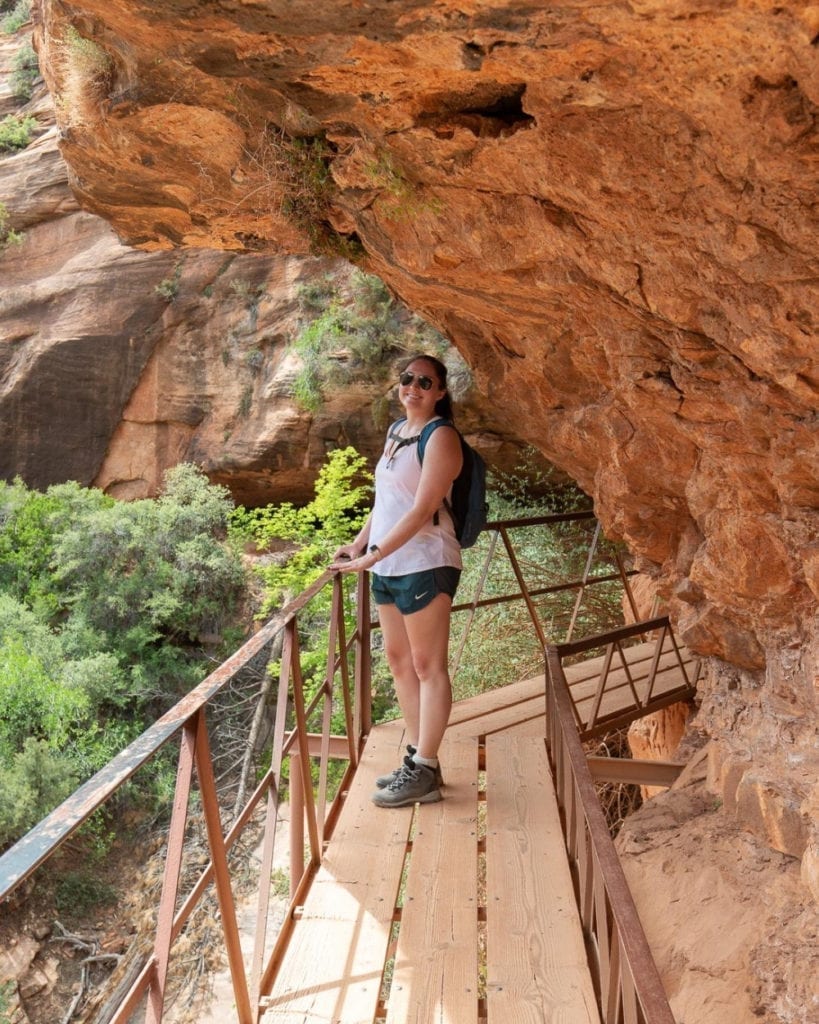
Tips for Planning a Trip to Zion National Park
Ready to start planning your trip to Zion National Park? Check out these helpful tips!
- Book your accommodations early. Campgrounds in Zion book up as soon as reservations are released, 6 months out. Hotels in nearby Springdale will book up too, so plan to make reservations 4 to 6 months out.
- Don’t plan on driving around the park. From Spring to Fall, all visitors to Zion are required to take the park’s shuttle that picks up and drops off at the visitor center. If you’re staying in Springdale, take the town shuttle to the visitor center instead of driving.
- Avoid crowds in busy months by starting your day early. Plan to take the first shuttle of the day into the park (usually around 6 am) and start your hikes early. By 10 am, lines to get into the park are long, often over an hour long.
- Avoid crowds by exploring off the beaten path. Consider a trip up to Kolob Canyons or hike less popular trails instead of the big 3: Angels Landing, The Narrows, and Observation Point.
- Visit other nearby national parks. Utah has so much to offer, with 5 national parks and countless more monuments and state parks! You can see all 5 parks on a Utah “Mighty 5” road trip or explore other nearby parks like Grand Staircase-Escalante National Monument.
- Check the Zion National Park website frequently for updates. Park conditions are always changing, particularly in light of the COVID-19 pandemic. As you plan your trip, check regularly for changes to park services, operating schedules, and trail closures.
Are you visiting multiple national parks in the next year? The America the Beautiful National Park Pass gets you into 400+ national park sites, including all 63 national parks, for 12 months!
Get your national park pass ahead of time for only $80.
What to Pack for Every Season in Zion National Park
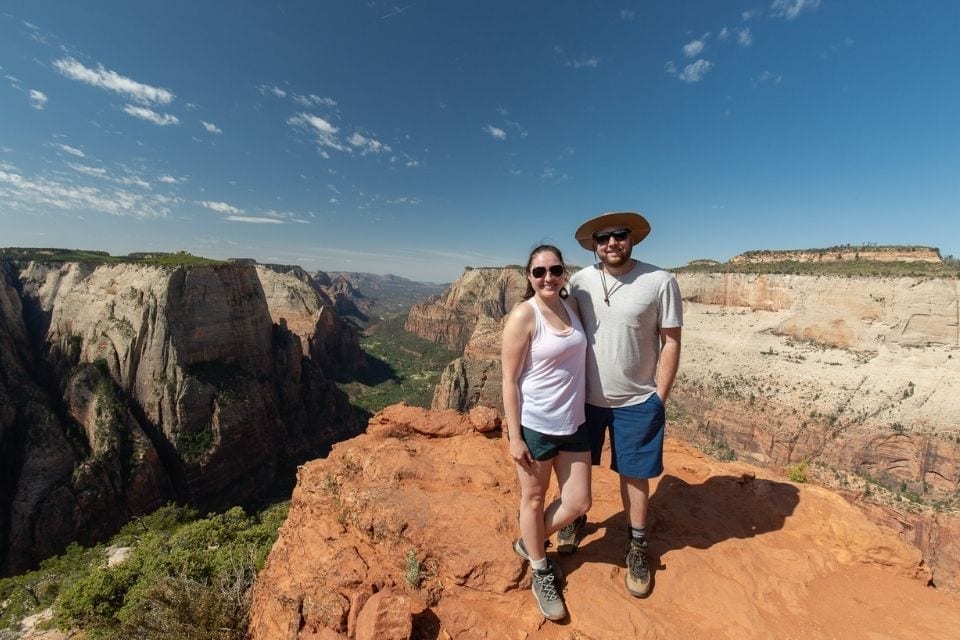
In any season, you’ll want these essentials to stay safe and comfortable while you explore this beautiful Utah national park.
- Layers. Zion National Park weather can vary dramatically from day to night, particularly in Spring and Fall. While the mornings may start off cool, afternoons can be hot. Pack moisture-wicking hiking shirts and warm fleece layers to keep you comfortable all day.
- Rain Jacket. In the summer, thunderstorms can spring up at any time. While it might just be a quick rain, it’s best to be prepared and always carry a rain jacket or poncho.
- Hiking Boots. The best thing to do in Zion National Park is hike. You’ll want sturdy, comfortable hiking boots or trail runners with solid traction. Don’t forget to break in your shoes before bringing them to Zion!
- Merino Wool Socks. Good hiking boots don’t mean anything if you have crappy socks. Always opt for merino wool socks. They might be a bit expensive, but they will last a long time, keep your feet dry, and protect you from blisters.
- Hiking Backpack and the 10 Essentials. It’s important to carry safety gear every time you hike, especially if you’re hiking in less busy seasons. Be sure to pack the 10 hiking essentials and bring a hiking backpack with plenty of room for water and extra gear.
- Sun Hat and Sunscreen. Many of Zion’s trails are unshaded, so it’s important to protect yourself from the sun. Sunscreen is obviously essential, but a sun hat will go a long way towards protecting you from sunburn too.
- Camera. You’ll want to capture every view in Zion National Park, but how you do that is up to you. Today, even an iPhone will do. If you choose to travel with a nice camera, I highly recommend investing in a sturdy camera clip to secure your camera to your hiking backpack.
If you’re visiting in the winter, don’t forget winter essentials like a down jacket, gloves, and warm hat.
Looking for more tips on what to pack for your trip? Check out my guides on the best hiking gear, what to pack for a road trip, and essential camping gear for all my favorite gear picks and tips to make packing for your trip a breeze!
Frequently Asked Questions About the Best Month to Visit Zion National Park
What is the best month to visit Zion National Park?
The best months to visit Zion National Park are March, April, October, or November. The weather is more mild, but all park facilities are open and crowds are fewer.
When should you not go to Zion National Park?
The summer months from June to August are the most crowded and have hot weather. Skip going to Zion National Park in the summer and instead visit in the Spring or Fall for better weather and fewer crowds.
What time should I get to Zion National Park?
Plan to arrive at Zion National Park before 9:00 AM. Parking lots fill and shuttle lines get long by mid morning. From Spring to Fall, all visitors are required to take the shuttles from the Zion Canyon Visitor Center.
What is the least busy day at Zion National Park?
The least busy day at Zion National Park is the week before and after Thanksgiving in November. The holidays and cold weather reduce crowds and visitors can drive through the park instead of taking the shuttle.
Final Thoughts on the Best Time to Visit Zion National Park
Zion National Park is beautiful all year long. I recommend avoiding the busier summer season and planning your trip in spring or fall. The best time to visit Zion National Park is April to May or September to October!
Planning a trip to Zion National Park? Don’t miss these posts!
- Visiting in 2024: Ultimate Guide to Zion National Park
- Observation Point: Hiking the Observation Point Trail
- Visit Bryce Canyon: 3-Day Zion & Bryce Canyon Itinerary
- Add Grand Canyon: 10-Day Grand Canyon and Zion Itinerary
- Utah Road Trip: 8-Day Utah National Parks Road Trip
- All Utah Parks: 14 Best National Parks in Utah
Don’t miss the best of Utah’s national parks on your upcoming trip! This free, printable Utah national park road trip itinerary covers all the best points of interest in all 5 Utah parks, plus bonus tips on where to stay and side trips to nearby state parks and monuments.
Download your free Utah road trip itinerary here.
Don’t Forget to Save This Post on Pinterest
